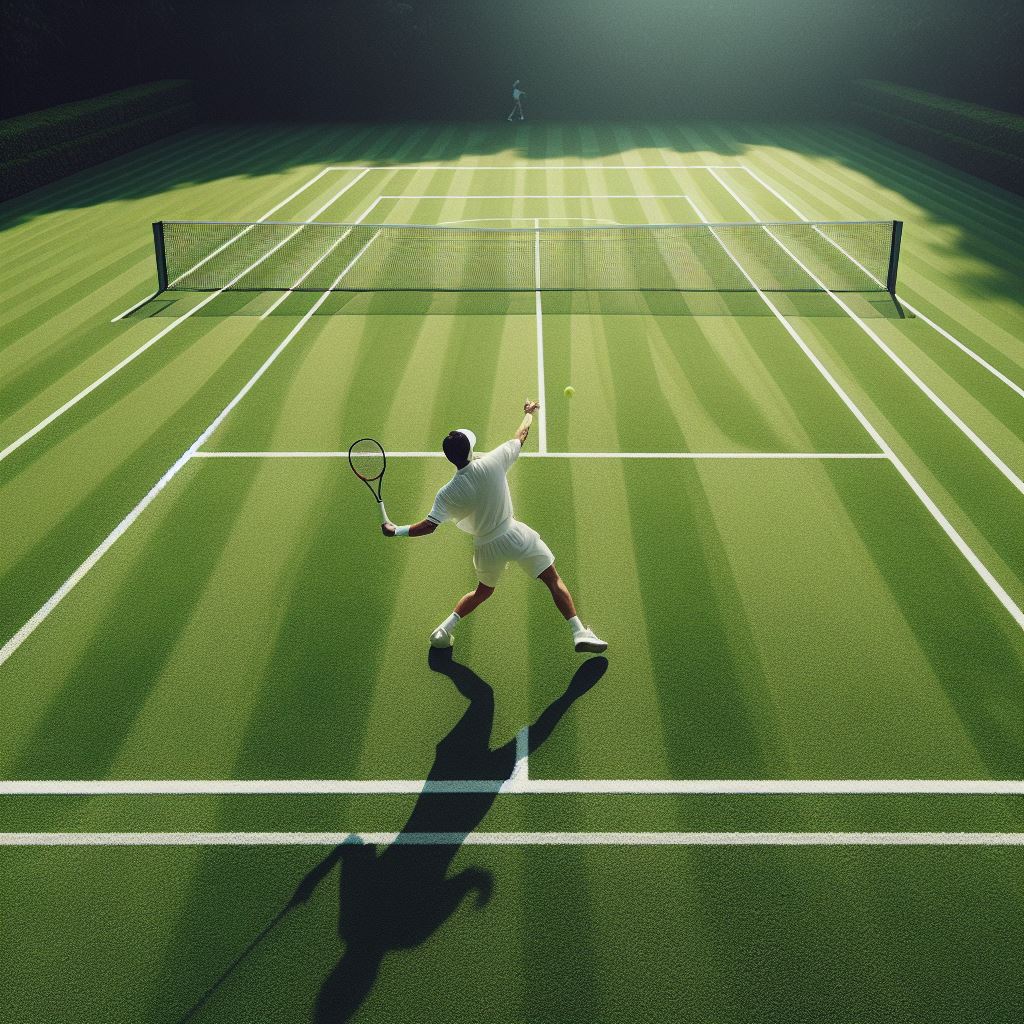In the world of competitive tennis, the serve is often referred to as the ‘game-changer.’ With a powerful and accurate serve, players can gain an instant advantage over their opponents.
However, mastering the art of the fast serve requires more than just brute force. It demands a deep understanding of proper technique, timing, and mental strategies.
In this article, we will explore the essential elements of fast serve mastery, providing valuable insights and practical tips to help players enhance their serve and gain that coveted edge on the court.
Key Takeaways
- Balance, footwork, and grip are crucial for a strong serve.
- Generating power requires shoulder rotation, hip initiation, and core stability.
- Mastering the toss is essential for accuracy and predictability.
- Timing, coordination, and efficient footwork are necessary for maximum speed in serving.
- Mental strategies such as deep breathing and visualization enhance performance.
Proper Stance and Grip
To achieve a fast serve mastery and gain an instant advantage in tennis, it is crucial to adopt a proper stance and grip. Your stance and grip lay the foundation for a powerful and accurate serve.
Balance and footwork are essential components of a strong serve, as they allow for a stable base from which to generate power. In terms of balance, it is important to distribute your weight evenly between your front and back foot. This ensures stability and allows for efficient transfer of energy from your legs to your serve.
Proper footwork is also crucial, as it helps you position yourself optimally for the serve. By taking small steps and maintaining a balanced stance, you can maximize your racket head speed and generate more power in your serve.
Additionally, the grip you use on the racket greatly impacts your ability to generate racket head speed. The continental grip, where the base knuckle of your index finger rests on the third bevel of the racket handle, is commonly used for serves. This grip allows for maximum wrist snap and racket head acceleration, resulting in a faster serve.
Generating Power Through Shoulder Rotation
Continuing from the previous subtopic, it is essential to consistently incorporate shoulder rotation to generate maximum power in your serve. Shoulder rotation plays a crucial role in the kinetic chain of a powerful serve, transferring energy from the lower body through the core and into the arm. By engaging the hips and maintaining core stability, players can optimize their shoulder rotation and unleash a faster and more explosive serve.
To better understand the importance of shoulder rotation, let’s examine the biomechanics involved. During the serve, the player’s shoulder joint goes through a significant range of motion, allowing for maximum acceleration and deceleration of the arm. This movement is facilitated by the engagement of the hips, which initiates the kinetic chain and generates power from the ground up. Simultaneously, core stability ensures proper transfer of energy and prevents any power leakage.
Incorporating shoulder rotation effectively requires precise coordination and timing. The following table highlights the key elements involved in generating power through shoulder rotation:
| Key Elements | Description |
|---|---|
| Hip Engagement | Initiates the kinetic chain and transfers power from the lower body to the upper body. |
| Core Stability | Ensures efficient energy transfer and prevents power leakage during the serve. |
| Shoulder Rotation | Facilitates maximum acceleration and deceleration of the arm, generating power for a faster serve. |
Mastering the Toss for Accuracy and Consistency
In the pursuit of fast serve mastery, achieving accuracy and consistency begins with mastering the toss. The toss is a critical element in serving, as it determines the ball trajectory and allows players to strike the ball at the optimal point.
To achieve accuracy, players must focus on controlling the toss height, direction, and spin. By consistently placing the toss in the same spot, players can better predict the ball’s trajectory and adjust their body positioning accordingly. This level of control allows for greater accuracy when serving, increasing the chances of hitting the desired target.
However, mastering the toss is not always an easy task, especially when facing nerves or pressure. It is common for players to experience nervousness before and during a serve, which can lead to inconsistent tosses. Overcoming this nervousness is crucial in maintaining accuracy and consistency.
Players can employ various techniques to manage nerves, such as deep breathing exercises, positive visualization, and mental preparation. By focusing on the process rather than the outcome, players can minimize the impact of nerves on their toss and serve performance.
Timing and Coordination for Maximum Speed
Achieving maximum speed in serving requires precise timing and coordinated movements. In order to generate power and speed, players must have a solid foundation of footwork techniques and understand the importance of utilizing their body weight effectively.
Footwork techniques play a crucial role in the timing and coordination required for a fast serve. The proper positioning of the feet allows the player to transfer energy efficiently from the ground up, maximizing the speed and power of the serve. By using quick and dynamic footwork, players can position themselves optimally to generate maximum force.
Additionally, utilizing body weight is essential for generating power in the serve. By shifting their weight from the back foot to the front foot during the serve, players can effectively transfer their body’s momentum into the shot. This transfer of weight adds force and speed to the serve, enabling players to hit the ball with greater velocity.
In conclusion, timing and coordination are essential for achieving maximum speed in serving. By mastering footwork techniques and utilizing body weight effectively, players can generate the power and speed needed for a fast serve.
In the next section, we will explore important mental strategies for staying calm and focused, which are crucial for maintaining consistency and accuracy in serving.
Mental Strategies for Staying Calm and Focused
To maintain a calm and focused mindset, players should employ specific mental strategies that enhance concentration and composure during the serving process. Two effective techniques are breathing techniques and visualization exercises.
Breathing techniques can help players manage their emotions and stay calm under pressure. Deep breathing, for example, can activate the body’s relaxation response and reduce anxiety. By taking slow, deep breaths before and during the serve, players can regulate their heart rate and experience a sense of calmness. This allows them to focus their attention on the task at hand, rather than being distracted by any negative thoughts or external factors.
Visualization exercises involve mentally rehearsing the serve before executing it. By vividly imagining themselves performing a successful serve, players can enhance their confidence and improve their performance. Research has shown that visualization can activate the same neural pathways as physical practice, leading to improved muscle memory and motor skills. By visualizing the entire serving process, from the initial toss to the follow-through, players can enhance their mental preparedness and increase their chances of success.
Frequently Asked Questions
How Can I Improve My Footwork to Enhance My Serve?
Improving footwork can enhance your serve by increasing balance and agility. Focusing on proper weight distribution, quick movements, and explosive power can help generate more speed and accuracy, resulting in a more effective serve.
What Are Some Common Mistakes to Avoid When It Comes to Grip and Stance?
Common grip mistakes include holding the racket too tightly or too loosely, which can hinder control and power. Proper stance techniques involve maintaining a balanced and stable position, with the feet aligned and the body weight evenly distributed.
Are There Any Specific Drills or Exercises I Can Do to Strengthen My Shoulder Rotation for a More Powerful Serve?
To strengthen shoulder rotation for a more powerful serve, it is recommended to incorporate specific shoulder mobility exercises into your training routine. Additionally, conducting a serving technique analysis can provide valuable insights for improvement.
How Can I Overcome Nerves and Pressure When It Comes to the Toss for Accuracy and Consistency?
To overcome nerves and pressure during the toss for accuracy and consistency in serving, mental preparation and focus are key. Techniques such as visualization, deep breathing, and positive self-talk can help athletes maintain composure and execute precise tosses.
Are There Any Specific Techniques or Cues to Help With Timing and Coordination to Achieve Maximum Speed on My Serve?
Serve technique analysis is essential for achieving maximum speed. Timing and coordination play crucial roles in generating racket head speed, which directly impacts the power of the serve. Understanding these factors can lead to improved performance on the court.
Conclusion
In the quest for tennis supremacy, mastering the fast serve is a crucial skill that can provide players with an instant advantage. By adopting the proper stance and grip, generating power through shoulder rotation, mastering the toss for accuracy and consistency, and honing their timing and coordination, athletes can unleash maximum speed on the court.
However, it is ironic that while the focus is on intense physicality, mental strategies for staying calm and focused are equally vital in achieving success.








No Comment! Be the first one.